《中学英语教学法》课程教学课件(PPT讲稿)Chapter 6 Contents of FLT(Vocabulary)

Chapter 6 Contents of FLT (1) Vocabulary Luo Beigang English Department of Foreign Languages School of SHZU
Chapter 6 Contents of FLT (1) Vocabulary Luo Beigang English Department of Foreign Languages School of SHZU
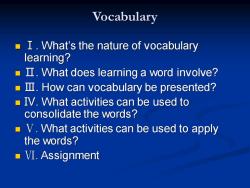
Vocabulary I.What's the nature of vocabulary learning? II.What does learning a word involve? II.How can vocabulary be presented? IV.What activities can be used to consolidate the words? V.What activities can be used to apply the words? VI.Assignment
Vocabulary ◼ Ⅰ. What’s the nature of vocabulary learning? ◼ Ⅱ. What does learning a word involve? ◼ Ⅲ. How can vocabulary be presented? ◼ Ⅳ. What activities can be used to consolidate the words? ◼ Ⅴ. What activities can be used to apply the words? ◼ Ⅵ. Assignment

I.What's the nature of vocabulary learning? ■Class discussion. What stages does vocabulary learning go through?
◼ Ⅰ. What’s the nature of vocabulary learning? ◼ Class discussion: ◼ What stages does vocabulary learning go through?
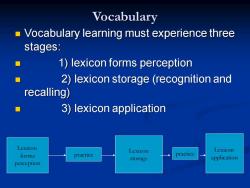
Vocabulary Vocabulary learning must experience three stages: 1)lexicon forms perception 2)lexicon storage (recognition and recalling) 3)lexicon application Lexicon Lexicon Lexicon forms practice practice storage application perception
Vocabulary ◼ Vocabulary learning must experience three stages: ◼ 1) lexicon forms perception ◼ 2) lexicon storage (recognition and recalling) ◼ 3) lexicon application Lexicon forms perception practice Lexicon storage Lexicon application practice
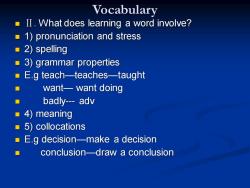
Vocabulary II.What does learning a word involve? 1)pronunciation and stress ■2)spelling 3)grammar properties E.g teach-teaches-taught ■ want-want doing ■ badly-adv ■4)meaning ■5)collocations E.g decision-make a decision conclusion-draw a conclusion
Vocabulary ◼ Ⅱ. What does learning a word involve? ◼ 1) pronunciation and stress ◼ 2) spelling ◼ 3) grammar properties ◼ E.g teach—teaches—taught ◼ want— want doing ◼ badly- adv ◼ 4) meaning ◼ 5) collocations ◼ E.g decision—make a decision ◼ conclusion—draw a conclusion

Note 1:What does mastering a word involve? ·Recognize the word Recall the word Comprehend the word in the context ■Apply the word
◼ Note 1: What does mastering a word involve? ◼ Recognize the word ◼ Recall the word ◼ Comprehend the word in the context ◼ Apply the word

Vocabulary Note 2:What's the meaning of meaning? ■1.Aspects of meaning Denotation-the base meaning of a word Connotation-the associations,positive and negative feelings a word creates n dog-a domestic carnivorous animal dog-loyalty dank-wet moist-wet dank-unfavorable moist-favorable cock-rooster
Vocabulary ◼ Note 2: What’s the meaning of meaning? ◼ 1. Aspects of meaning ◼ Denotation—the base meaning of a word ◼ Connotation—the associations, positive and negative feelings a word creates ◼ dog—a domestic carnivorous animal ◼ dog– loyalty ◼ dank—wet moist—wet ◼ dank—unfavorable moist—favorable ◼ cock-rooster
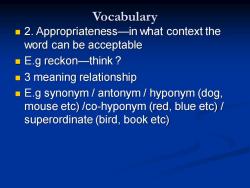
Vocabulary 2.Appropriateness-in what context the word can be acceptable ■E.g reckon-think? 3 meaning relationship E.g synonym antonym hyponym (dog, mouse etc)/co-hyponym (red,blue etc)/ superordinate(bird,book etc)
Vocabulary ◼ 2. Appropriateness—in what context the word can be acceptable ◼ E.g reckon—think ? ◼ 3 meaning relationship ◼ E.g synonym / antonym / hyponym (dog, mouse etc) /co-hyponym (red, blue etc) / superordinate (bird, book etc)

4 word formation ■E.g suffixes/prefix
◼ 4 word formation ◼ E.g suffixes / prefix
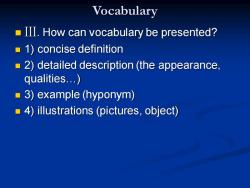
Vocabulary III.How can vocabulary be presented? 1)concise definition 2)detailed description (the appearance, qualities.) ■3)example(hyponym) 4)illustrations (pictures,object)
Vocabulary ◼ Ⅲ. How can vocabulary be presented? ◼ 1) concise definition ◼ 2) detailed description (the appearance, qualities.) ◼ 3) example (hyponym) ◼ 4) illustrations (pictures, object)
按次数下载不扣除下载券;
注册用户24小时内重复下载只扣除一次;
顺序:VIP每日次数-->可用次数-->下载券;
- 《中学英语教学法》课程PPT讲稿(学科教学论)Chapter Three Introduction of learning theory(1/2).ppt
- 《中学英语教学法》课程PPT讲稿(学科教学论)Chapter five History of Foreign Language Teaching.ppt
- 《中学英语教学法》课程PPT讲稿(学科教学论)Chapter Four Introduction of SLA Theories(2/2).ppt
- 《中学英语教学法》课程PPT讲稿(学科教学论)Chapter Four Introduction of SLA Theories(1/2).ppt
- 《中学英语教学法》课程PPT讲稿(学科教学论)Chapter Six Introduction of Class Teaching Implementation.ppt
- 《中学英语教学法》课程PPT讲稿(学科教学论)Chapter seven Assessment.ppt
- 《中学英语教学法》课程PPT讲稿(学科教学论)Chapter eight Theories of Test(2/2).ppt
- 《中学英语教学法》课程PPT讲稿(学科教学论)Chapter eight Theories of Test(1/2).ppt
- 《中学英语教学法》课程PPT讲稿(学科教学论)Chapter nine Language Teachers in Classroom Teaching.ppt
- 《中学英语教学法》课程PPT讲稿(课堂教学策略)高中英语课堂观察与评价.ppt
- 《中学英语教学法》课程PPT讲稿(课堂教学策略)英语教师语言敏感意识提升与课堂教学——基于观课的反思.ppt
- 《中学英语教学法》课程PPT讲稿(课堂教学策略)如何开展培训需求分析.ppt
- 《中学英语教学法》课程PPT讲稿(课堂教学策略)树立正确的外语学习观是提高外语教学效率的关键.ppt
- 《中学英语教学法》课程PPT讲稿(课堂教学策略)英语老师行动研究 English Teachers inAction Research.ppt
- 《中学英语教学法》课程PPT讲稿(课堂教学策略)初中英语有效教学策略探讨.ppt
- 《中学英语教学法》课程PPT讲稿(课堂教学策略)初中英语教学评价.ppt
- 《中学英语教学法》课程PPT讲稿(课堂教学策略)对中小学外语教学中科研的几点看法.ppt
- 《中学英语教学法》课程PPT讲稿(课堂教学策略)课堂教学设计-提升课堂教学有效性的基本路径.ppt
- 《中学英语教学法》课程PPT讲稿(课堂教学策略)学业成绩不良的诊断与预防.ppt
- 《中学英语教学法》课程教学资源:英语教学中的简笔画.doc
- 《中学英语教学法》课程教学课件(PPT讲稿)Chapter 9 Class observing strategies.ppt
- 《中学英语教学法》课程教学课件(PPT讲稿)Chapter 7 Microteaching skills(Reading).ppt
- 《中学英语教学法》课程教学课件(PPT讲稿)Chapter 8 Teaching strategies(Lead in strategies).ppt
- 《中学英语教学法》课程教学课件(PPT讲稿)Chapter 5 Schools of FLT methods(2/4).ppt
- 《中学英语教学法》课程教学课件(PPT讲稿)Chapter 5 Schools of FLT methods(4/4).ppt
- 《中学英语教学法》课程教学课件(PPT讲稿)Chapter 5 Schools of FLT methods(3/4).ppt
- 《中学英语教学法》课程教学课件(PPT讲稿)Chapter 5 schools of FLT methods(1/4).ppt
- 《中学英语教学法》课程教学课件(PPT讲稿)Chapter 3 Teaching planning.ppt
- 《中学英语教学法》课程教学课件(PPT讲稿)Chapter 1 Instructional views in New Curriculum.ppt
- 《中学英语教学法》课程教学课件(PPT讲稿)Chapter 4 Teaching designing(Lesson planning).ppt
- 《中学英语教学法》课程教学课件(PPT讲稿)Chapter 2 Key issues in Foreign Language Teaching Methodology.ppt
- 《俄语语法》课程教学大纲 Russian grammar.doc
- 石河子大学:《俄语语法》课程教学资源(试卷习题)2013-2014俄语语法(二)期中答案.doc
- 石河子大学:《俄语语法》课程教学资源(试卷习题)2013-2014俄语语法(二)期中卷.doc
- 石河子大学:《俄语语法》课程教学资源(试卷习题)语法二期末试卷及答案_2013-2014(2)俄语语法(二)A答案.doc
- 石河子大学:《俄语语法》课程教学资源(试卷习题)语法二期末试卷及答案_2013-2014(2)俄语语法(二)A卷.doc
- 石河子大学:《俄语语法》课程教学资源(试卷习题)语法四期末试卷及答案_2013-2014(2)俄语语法(四)A答案.doc
- 石河子大学:《俄语语法》课程教学资源(试卷习题)语法四期末试卷及答案_2013-2014(2)俄语语法(四)B答案.doc
- 石河子大学:《俄语语法》课程教学资源(试卷习题)语法四期末试卷及答案_2013-2014(2)俄语语法(四)A卷.doc
- 石河子大学:《俄语语法》课程教学资源(试卷习题)语法四期末试卷及答案_2013-2014(2)俄语语法(四)B卷.doc
